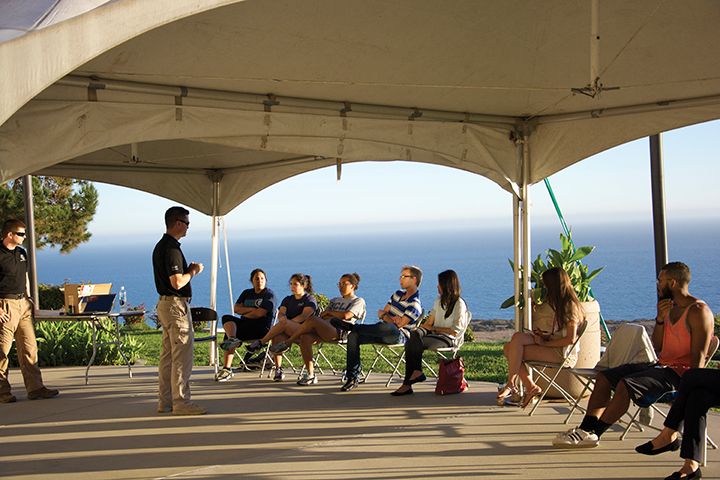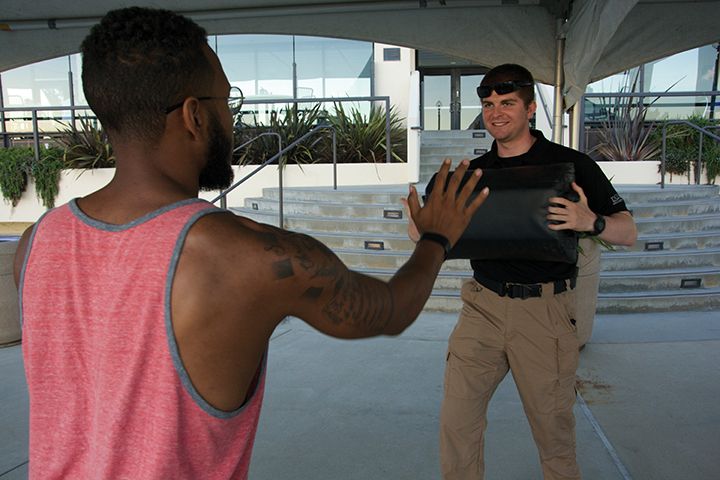Photos by Arin DeGroff
A series of smacks and thuds emanate from the Fireside Room as students and faculty practice striking punch pads with their open palms.
“See how powerful that is?” instructor Chris Dunn yelled above the noise. “Super powerful.”
Dunn is a part of Covered 6, a security consulting and tactical training group that is offering free one-hour awareness and self-defense classes against physical threats (ADAPT) throughout September in the Fireside Room and the Center for Communication and Business in room 140. The next set of classes will be held at CCB 140 on Saturday and Tuesday.
The first round of classes began Friday and will run until Tuesday. This year is the first that Covered 6 will be holding the class in two parts: an introductory course and a hands-on session where participants will be able to test their skills on instructors in padded suits. The second sessions have yet to be scheduled, but Dunn said they will likely be held in October.
Dunn, who has 20 years of experience in martial arts, self-defense and public safety, said that it is important for everyone to practice awareness and know how to physically react, even if they live in a place where they feel safe.
“I think it’s a good thing for people, mainly because Pepperdine is so safe that it lulls you a little bit into, ‘It’s so safe, don’t worry about anything,’” he said. “Well it’s not that — we’re in the real world, and they do have public streets that surround [the university] and Pepperdine’s really concerned about people off campus as well as on campus.”
The introductory course focused on key factors for avoiding and escaping attack: awareness, body language and “bash and dash” techniques to quickly disable an attacker and escape.
Senior Lindsay Kawano heard about the class from her friend Ashley Chaparro, a first-year graduate student at the School of Public Policy who also attended the session.
“It just sounded interesting and I’d never taken a [self-defense] class before, so I thought it was cool,” Kawano said, adding that learning about palm strikes was especially useful, because her natural instinct is to punch. “It’s good just to know the basics,” she said.
Dunn dedicated the first 30 minutes of the presentation to discussing ways to prevent an attack by simply being aware of surroundings and knowing when to step away from a potentially dangerous situation.
“Stay alert, stay alive,” he said. “That’s what we tell our military guys.”
He also discussed common self-defense tools, including pepper spray and keys held in fists, noting their weaknesses and downfalls.
While pepper spray is easily found in stores, easy to carry and allowed on campus, most brands only provide enough spray for one use, meaning users cannot test it to make sure it works. Additionally, Dunn noted, pepper spray affects everyone within range, including the individual who deployed it. Keys, while convenient, create a disadvantage if they are lost in the fight or are not accessible to open the door to a car or building and escape.
Ultimately, Dunn recommended that students and faculty alike invest in a small, high-powered flashlight, which can be used as a distraction when flashed in an attacker’s face, a signal in the case of a power outage or car emergency or even a striking device in combat.
“We consider light a weapon,” he said. “It’s so effective. Light is an amazing friend for us, especially at night.”
In the second half of the class, participants learned a variety of quick strikes meant to disable and distract. These techniques included palm strikes, elbow strikes, kicks and knees. Dunn also taught participants how to break free from wrist grabs, chokes, bear hugs and the sleeper hold, a chokehold that renders victims unconscious within seconds.
Even with all of the self-defense skills taught in the class, instructor Chris Throgmorton stresses that following one’s instinct is one of the most important things one can do in any given situation.
“What I tell everyone is to follow your gut,” he said. “If your gut’s telling you something’s wrong, something’s wrong. Our subconscious is constantly analyzing everything that’s happening around us, and it brings that all back to us.”
Chaparro said the class taught her that simple things, like being aware of her surroundings and not being too trusting, can matter in big ways.
“It’s worth your time — it’s just an hour, and you never know if something could happen to you, and maybe just this one hour could have protected you from a situation,” she said.
For Dunn, the main goal of the program is to “motivate people to take action for themselves.”
“It might not be taking martial arts,” he said. “It might just be, ‘Maybe I need a flashlight. Oh, you know what, I’m going to get something good.’ If you do one thing, it’s one step in the right direction that might change somebody’s life, and that’s why we do it.”
__________
Follow the Graphic on Twitter: @PeppGraphic



